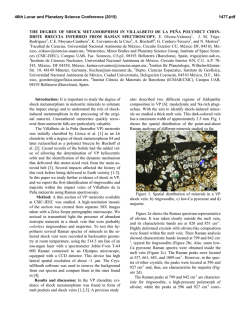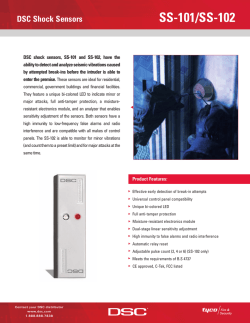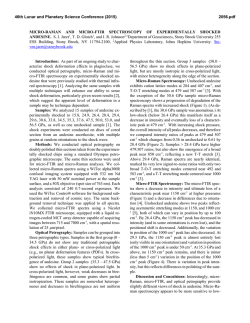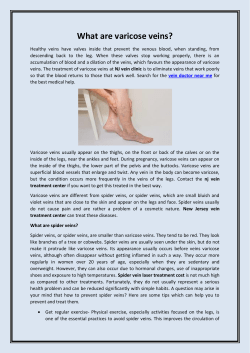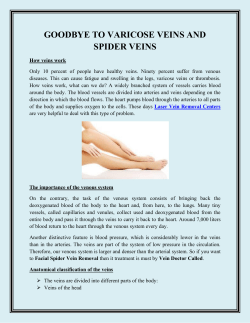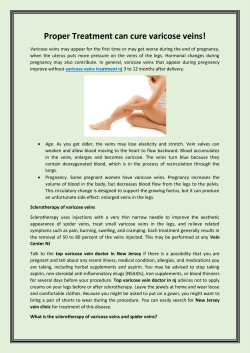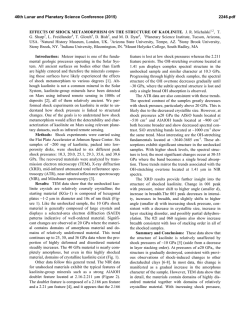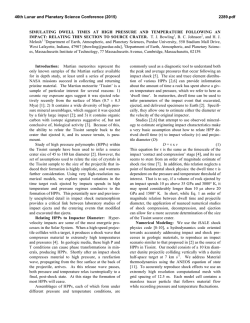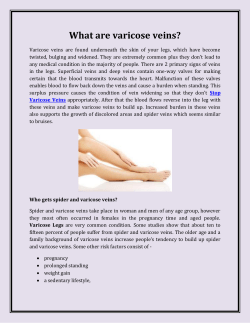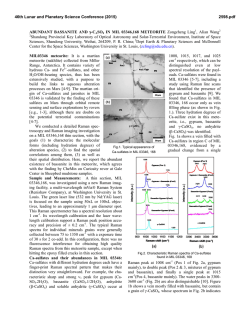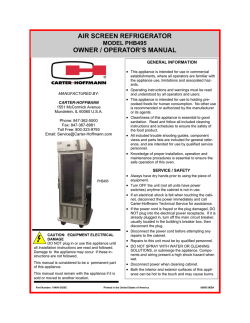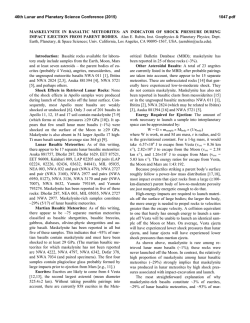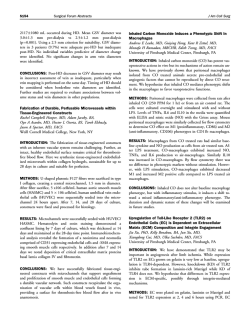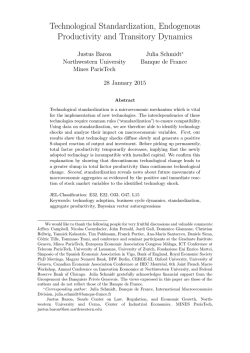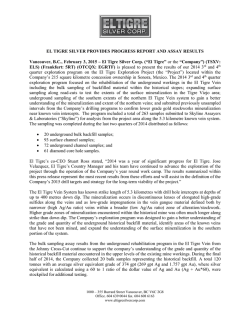
The high-pressure mineral inventory of shock veins from the Steen
46th Lunar and Planetary Science Conference (2015) 2512.pdf The high-pressure mineral inventory of shock veins from the Steen River impact structure. Walton E.L., Sharp T. G. and Hu J. 1MacEwan University, Department of Physical Sciences, 10700 104 Ave, Edmonton, AB, T5J 2S2, Canada ([email protected] / [email protected] ), 2University of Alberta, Department of Earth & Atmospheric Sciences, Edmonton, AB, T6G 2E3, Canada. 3Arizona State University, School of Earth & Space Exploration,Tempe, AZ 85287-1404, USA. Introduction: The Steen River impact structure (SRIS; 59o31'N, 117o39’W) is a buried complex crater with an apparent diameter of ~25 km [1]. The SRIS is the largest known impact structure in the Western Canada Sedimentary Basin and is a producer and host of oil and gas reservoirs [1]. The target rocks comprise a 70 m layer of Missippian calcareous shale underlain by a thick (1530 m) sequence of Devonian marine sedimentary rocks including carbonates and evaporates. This ~1.6 km thick sedimentary cover overlies Precambrian basement rocks (primarily granite / gneiss / granodiorite). A variety of shock metamorphic effects have been observed at the SRIS, including kink banding in biotite, planar fractures and planar deformation features in quartz and feldspar, ballen quartz, lechatelierite and diaplectic glasses of feldspar and quartz [2, 3, 4], which helped to ascribe a hypervelocity impact origin to this structure. Despite the documentation of diagnostic shock effects in minerals, mostly quartz and feldspar, uncertainty as to the origin of the SRIS structure by volcanic or meteoritic origin remains, primarily within the industrial sector (e.g., [5]), with terms such as “pitchstone” and “tuff” used to describe the SRIS impactites. A portion of this uncertainty lies in the inability of previous studies to isolate high-pressure, high-temperature minerals such as the SiO2 polymorphs coesite and stishovite in SRIS deposits. This may also reflect the lack of recognition of impact cratering as a ubiquitous geologic process outside the planetary science community. Here, the results of a combined SEM, EMPA, Raman and TEM study of shock veins in the central uplift of the SRIS are reported. These shock veins exhibit a unique assemblage of high-pressure, high-temperature minerals within and around shock veins. This study clarifies the impact origin of the SRIS, helps to elucidate the location and distribution of high-pressure minerals in impact structures, and constrains the P-T conditions experienced by rocks in the central uplift of a moderate-size complex impact structure. Anaytical Methods: A total of 44 polished thin sections were prepared from core offcuts for petrographic analysis (optical microscopy). From these, several thin section were selected for detailed investigation using a Zeiss EVO MA LaB6 filament SEM in BSE imaging mode, focusing on the minerals associated with the shock veins. Major and minor element abundances were analyzed with a JEOL 8900 EMPA equipped with five WDS spectrometers. Raw data were corrected using the ZAF procedure. The excel spreadsheets of [6,7] where used to recast chemical analyses of amphiboles and garnets following the IMA reccomentations. Micro-Raman spectra of various phases were obtained with point measurements, using a Bruker SENTERRA instrument. The 100X objective of a petrographic microscope was used to focus the excitation laser beam (532 nm line of Ar+ laser) to a focal spot size of ~1 µm. TEM sections will be prepared using an FEI Nova200 NanoFab dual-beam FIB, focusing on the shock vein and associated transformed minerals. Analytical TEM will be done using an FEI CM200 FEG. High-pressure minerals will be indentified using a combination of electron diffraction, EDX and imaging. Transformation microstructures will also be investigated to illucidate the mechanisms of hornblende and biotite transformation. Sample Selection: In early 2000, New Claymore Resources Ltd drilled three continuous drill holes into the allochthonous proximal deposits of the SRIS. One (ST003) penetrated the central uplift. This core, previously logged in detail by [4], has been re-visited in this study (see Walton et al. LPSC companion abstract for a description of ST003 impactites). Sample names in the following description refer to depth (in meters). The lower 10 m of the hole (between 352‒377.4 m) comprises granitic to gneissic rocks of the Precambrian basement. Fabrics in these rocks are cut across by thicker mm-size veins of finely-comminuted meltbearing material and thin, opaque veins. These micropseudotachylites are similar to shock veins in meteorites, and the general term for all these shock-induced melt veinlets will be referred to as “shock veins” following [8]. These shock vein-bearing rocks represent either meter-size megablocks within the allochthonous impactites or more likely the hole penetrated the central uplift. An anastomosing network of thin shock veins (<1 µm up to 0.5 mm apparent diameter) in a plagioclase-amphibole-biotite-quartz gneiss was sampled at a depth of 374 m. Apatite, zircon, ilmenite, titanite and chloritized biotite occur as accessory phases. Results: Quartz and plagioclase in the granitic gneiss, far away from the shock vein, exhibit planar deformation features (up to three distinct orientations in quartz) with weak to moderate mosaicism. Plagioclase, in a zone ~0.5 mm surrounding the shock vein, 46th Lunar and Planetary Science Conference (2015) has transformed to maskelynite, a diaplectic glass of feldspar composition. Quartz near the shock vein possesses an unusual texture of thin veins or elongated aggregates surrounded by smooth silica glass. Raman spectra contain peaks at 464 cm-1 and 520 cm-1, indicating an intimate mixture of α-quartz and coesite. Amphibole in the host rock is pleochroic in shades of green, yellow-green and brown. EMPA analyses show that it is ferro-pargasite with general formula (Na0.41K0.27)(Ca1.82Na0.10Mn0.08)(Fe2+3.04Mg1.33Al0.29Ti0.1 3+ Within a zone 9Fe 0.14)(Si6.60Al0.40)O22(OH)2. ~100‒300 µm along the shock vein margin and clasts entrained within the shock vein matrix, ferro-pargasite has undergone a nearly isochemical phase transformation to garnet. This is observed under plane polarized light as a striking transition from green amphibole to a bright orange garnet. The garnet is weakly anisotropic. The shock-transformed pargasite is almandine, (Fe1.37Ca0.97Mg0.42Na0.2Mn0.05)(Al0.92Si0.36Fe0.35Mg0.22Ti0. 10)Si3O12, with a 36% majorite component (based on 0.36 pfu of Si in the octahedral site). The pargasitealmandine phase transformation was nearly isochemical, with the exception of the most volatile species (Na, K and Cl). Raman spectra collected on ferropargasite show sharp peaks at 150, 533, 660-667 and 734 cm-1, characteristic of well-crystallized amphibole. Spectra collected on almandine garnets show peaks near 360 and 910 cm-1. Biotite in direct contact with the shock vein has also undergone a phase transformation. This biotite breakdown material is opaque in transmitted light and appears to be Raman inactive, although one spectrum obtained on this material showed a single peak at 667 cm-1 (12 additional spectra were collected, none of which yielded a useful spectra). BSE images show a brighter greyscale of this phase compared to adjacent non-transformed biotite. EMPA analyses show enrichment in Al, Fe and Mg, and depletion in Ti, K, Na and Cl compared to biotite. Totals for wt% oxides close to 100 for this phase indicate that it is anhydrous. The matrix of the shock vein is opaque in plane light, ranging from black, reddish-brown to grey. BSE imaging show the texture to be fine-grained (≤2 µm) and granular. The largest micron-size crystals were analyzed with Raman and EMPA, and found to be almandine garnet with general formula (Fe1.54Mg1.31Ca0.05Na0.04Mn0.03)(Al1.81Si0.11Mg0.04Ti0.03) Si3O12. These garnets also have a majorite component, but in this case only 11% compared to shocktransformed garnets within the host rock which have a higher (36%) majorite component. Raman spectra collected on the vein matrix show peaks at ~360 cm-1 and 910 cm-1, consistent with garnet as the main mineral; however, peak positions near 660 cm-1 and 1113 cm-1, suggest that pyroxene may also have crystallized from 2512.pdf the shock melt. One spectra from the vein matrix was consistent with the presence of shishovite with a sharp peak at 750 cm-1. TEM work is needed to confirm this. Discussion: The majorite component in the shockproduced garnets at the SRIS is a strong indicator of high pressure. This is consistent with the presence of coesite and stishovite, as well as the transformation of plagioclase to maskelynite, only in those grains within or surrounding the shock vein. Although both garnets are shock-produced, their distinct texture and composition implies a different formation mechanism (solid state transformation of amphibole vs. crystallization from impact melt). A shock pressure estimates of 15‒17 GPa for similar amphibole-garnet transformations described by [9] from shock veins in clasts within suevite of the ~25 km diameter Ries impact structure, also apply to the same phase transformation described here for the SRIS. The coexistence of crystalline plagioclase and maskelynite suggests a moderate shock pressure of 16–23 GPa [10], and is constitent with, but slightly higher than, the 15‒17 GPa required to produce the majorite-bearing garnets. Conclusions: In meteorites, the association between minerals stable at high pressures and temperatures and shock veins is well-documented [e.g., 10]. However, the high-pressure mineral inventory of shock veins from terrestrial impact structures has been described in detail by relatively few researchers. Previous studies of impactites at the SRIS failed to identify high-pressure mineral polymorphs largely because they were looking in the wrong place, i.e., small clasts in clast-rich impactites which remain hot after shock pressure release. In these rocks high pressure minerals are less likely to be preserved because they will rapidly back-transform to their lower pressure compositional equivalents. The high pressure mineral inventory documented in this study formed at ~15‒23 GPa, and are preferentially associated with thin shock veins in large meter-size blocks of crystalline basement where postshock temperatures were low enough to preserve these minerals. References: [1] Grieve 2006. Impact Structures in Canada, pp. 210. [2] Carrigy & Short, 1968. Shock Meta. Nat. Materials, pp. 367-378. [3] Winzer, 1972. 24th Int. Geol. Congress Proc., pp. 148-156 [4] Molak et al., 2002. AEUB OFR Earth Sci. Report 2001-04. [5] Brown 1995. AEUB Metallic Min. Assess. Report 19950015. [6] Locock 2014. Comput. & Geosci. 62:1-11. [7] Locock 2008. Comput. & Geosci. 34:1769-1780. [8] Stöffler & Grieve 2007 In: Met. Rocks, pp. 82-92. [9] Stähle et al. 2011. Contrib. Miner. Petrol. 161:275-291. [10] Kubo et al. 2009 Nat. Geo. DOI: 10.1038. [11] Walton et al. 2014 GCA 140:334-348.
© Copyright 2026
